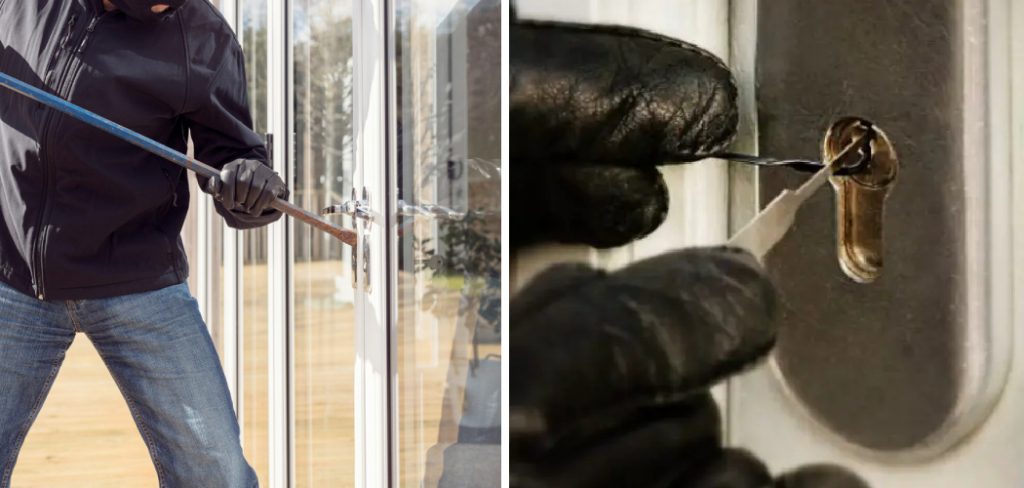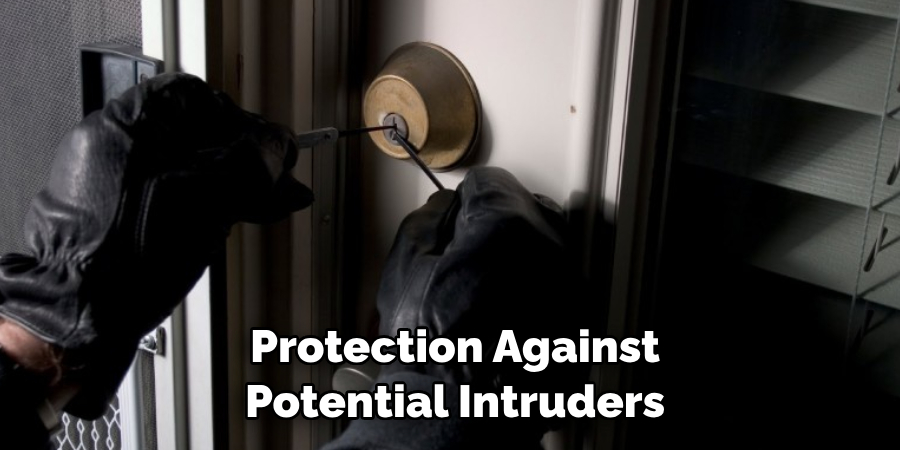Have you ever worried about someone breaking into your home or car? If so, lock picking is one of the tools intruders may use to gain access. With some knowledge and practice, anyone can pick most standard door locks in just minutes. Luckily, there are some effective steps you can take to stop people from picking your lock and keep you and your belongings safe.

If you suspect someone might be trying to break into your home or car, always make sure all locks are secured and in good working condition.
In this blog post, we’ll discuss lock picking, why it’s important to protect yourself against it, and how exactly you can defend against a potential intruder trying to pick their way into your home or vehicle. Read on for tips on how to stop someone from picking your lock!
What Will You Need?
- High quality locks
- Lock picking tools such as a tension wrench and a pick set
- Metal coat hangers or paper clips (if you’re in a bind)
Once you’ve got the necessary tools, it’s time to start!
8 Easy Steps on How to Stop Someone From Picking Your Lock
Step 1. Upgrade Your Locks
The first line of defense is to invest in high-quality locks. Traditional pin and tumbler locks are the most common types of locks, but they are also the easiest to pick. Consider upgrading to either a deadbolt or a smart lock. Deadbolts are much harder to pick, and smart locks require a code or a smartphone to unlock. If you’re particularly concerned about lock-picking, consider buying a lock with pick-resistant features. These locks have specially designed pins that are difficult to manipulate, making them more resistant to lock picking.
Step 2. Install Security Pins

Security pins are an excellent investment for those who want to fortify their locks against picking. These pins are specially designed to bind in the lock cylinder when someone tries to pick the lock, making the process much more difficult. They come in various designs, such as spool pins and serrated pins, each offering different levels of resistance to lock picking. To install security pins, you can either hire a locksmith or do it yourself if you possess the necessary skills and tools.
Step 3. Regularly Inspect Your Locks
Periodic inspection of your locks is another essential step in ensuring their integrity against picking attempts. Look for signs of wear and tear or any foreign objects stuck in the keyhole that might indicate tampering. If you notice anything unusual, it might be worthwhile to either repair the lock or replace it entirely. Remember, a compromised lock is an open invitation for intruders, so it’s better to be safe than sorry.
Step 4. Use a Lock with a Complex Keyway
The design of a lock’s keyway can significantly impact its susceptibility to picking. A lock with a complex, paracentric keyway (one where the wards on either side project into the keyway) can be much more challenging to pick than others.

This is because the shape of the keyway restricts the movement of picking tools, making it harder for an intruder to manipulate the lock pins. Although such locks may be more expensive, they offer a higher level of security and can be a worthy investment for your peace of mind.
Step 5. Install a Security Plate or Strike Plate
A security plate or strike plate is an additional layer of protection that can deter intruders from picking your lock. They are metal plates installed in the door frame, providing extra security by making it more difficult for someone to force the door open even if they successfully pick the lock. When choosing a security plate, opt for one made of solid metal and ensure it is securely fastened to the door frame with long, sturdy screws. This step may require more effort to install, but the added security is well worth the investment.
Step 6. Use Anti-Lock Bumping Devices
Lock bumping is a lock-picking technique that intruders might use to gain access. Consider using anti-lock bumping devices like bump-proof locks or bump keys to mitigate this risk. Bump-proof locks have unique pin configurations that resist the bumping process, while bump keys can be used to deaden the impact of a bump attack, rendering it ineffective.

These devices can be excellent additions to your security plan, providing an extra layer of protection against potential intruders.
Step 7. Re-key Your Locks Regularly
Changing the keys and re-keying your locks regularly is another effective measure to prevent lock picking. This is particularly useful if you’ve lost your keys or if you suspect that unauthorized copies might be in circulation. Re-keying involves changing the internal workings of the lock, rendering the old keys useless. This way, even if someone has a copy of your old key, they won’t be able to use it to pick the lock. It’s always a good idea to re-key the locks when you move into a new house or apartment, as you can never be too sure who might still have keys to the place.
Step 8. Install Security Cameras
Security cameras can significantly discourage potential intruders while not a direct deterrent for lock picking. Security cameras are effective in two ways: they can deter criminals who might think twice before attempting to pick your lock if they know they’re being watched and provide valuable evidence if a break-in occurs. Ensure to install cameras in conspicuous places and at all major entry points to your home. If cameras are outside your budget, even fake cameras can act as a deterrent.
By following these steps, you can better protect yourself from lock-picking attempts. Invest in high-quality locks, install security pins and plates, and re-key your locks regularly to keep your home safe. Remember that the best way to stay secure is to remain vigilant and take all necessary steps to make it as difficult as possible for an intruder to pick their way into your property.
5 Additional Tips and Tricks

- Invest in a high-quality lock that’s resistant to picking. Look for locks with features such as anti-pick pins, which are harder to manipulate and provide additional protection against break-ins or tampering.
- Keep your keys safe and secure by using a combination of security measures, such as an alarm system, keychain locks, and secure storage places for your keys.
- Secure the area around your door, as criminals can often access a lock by using tools such as pry bars or crowbars to open the doorframe and then pick the lock.
- Use security features like deadbolts or reinforced doors and locks to protect against forced entry attempts.
- If you suspect someone has attempted to pick your lock, call a professional locksmith to change it and inspect it for any damage immediately. This will help you maintain the security of your home or business.
With all these tips and tricks in mind, you’ll be sure to keep your lock secure from pickers. If you ever have any concerns about the safety of your locks, don’t hesitate to contact a reputable professional locksmith for help.
5 Things You Should Avoid
- Never share your key or access code with anyone you don’t completely trust.
- Don’t keep spare keys hidden outside of the property, as they can be easily found and used to break in.
- Avoid leaving a door unlocked, even if it’s just for a few minutes, since criminals often take advantage of this window of opportunity.
- Refrain from using cheap locks as they are often easier to pick than expensive ones.
- Don’t try to pick the lock yourself, as this could damage the lock and also leave you vulnerable to potential break-ins.
By following these general guidelines and taking appropriate precautions, you can ensure your locks remain safe from unwanted intruders. You can feel confident that your home or business is well-protected with the right security measures.
Conclusion
It is never recommended to try and pick someone else’s lock, regardless of the reason. If you’re curious about how the process works or just want to learn a new skill, it’s always best to use a dummy lock on a practice board so that you can understand the basic principles. Even then, it might take some time before you have mastered this art. If someone does try to pick your lock, several steps can be taken to ensure your security and safety.
Utilizing extra locks with anti-pick technology, alarm systems, or simply covering up your locks can all help keep anyone from trying to pick your lock and gain access to your home or valuables. Taking proactive steps is always the best way to ensure no one gains unauthorized access. Having an understanding of both how lock picking works and what strategies exist for preventing such activities will give you peace of mind in knowing that your possessions and home are safe from harm.
Hopefully, the article on how to stop someone from picking your lock has been insightful and of help. Remember these tips, and you’ll be sure to keep your property secure from unwanted intruders. Good luck!
About
Safety Fic is a distinguished figure in the world of Diy design, with a decade of expertise creating innovative and sustainable Diy solutions. His professional focus lies in merging traditional craftsmanship with modern manufacturing techniques, fostering designs that are both practical and environmentally conscious. As the author of diy, Safety Fic delves into the art and science of Safety Fic-making, inspiring artisans and industry professionals alike.
Education RMIT University
(Melbourne, Australia) Associate Degree in Design (Safety Fic) Focus on sustainable design, industry-driven projects, and practical craftsmanship. Gained hands-on experience with traditional and digital manufacturing tools, such as CAD and CNC software.
Nottingham Trent University
(United Kingdom) Bachelor’s in diyfastly.com and Product Design (Honors) Specialized in product design with a focus on blending creativity with production techniques. Participated in industry projects, working with companies like John Lewis and Vitsoe to gain real-world insights.
Publications and Impact
In diy, Safety Fic his insights on indoor design processes, materials, and strategies for efficient production. His writing bridges the gap between artisan knowledge and modern industry needs, making it a must-read for both budding designers and seasoned professionals.
